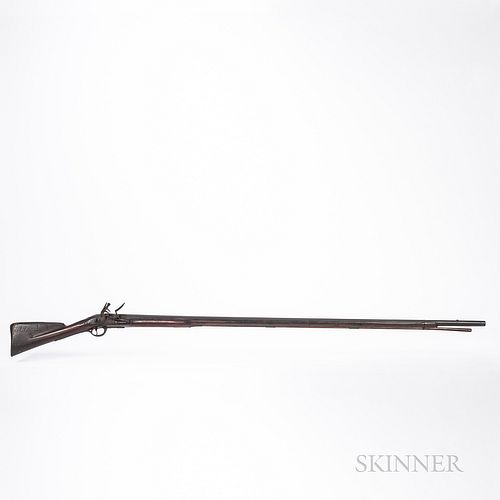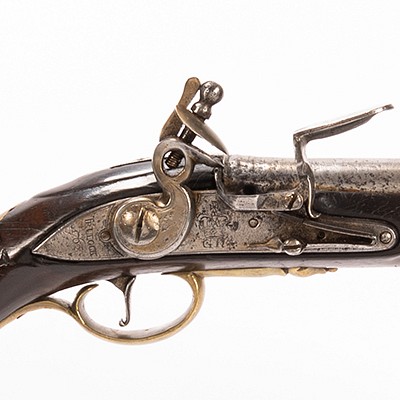Pattern 1756 Long Land Service Musket Carried by Edmund D. Thomas of the New Jersey Continental Line with "C13" Mark and Later Modified as a Fowler
Lot 98
About Seller
Bonhams Skinner
274 Cedar Hill Street
Marlborough, MA 01752
United States
Founded over four decades ago, Bonhams Skinner offers more than 60 auctions annually. Bonhams Skinner auctions reach an international audience and showcase the unique, rare, and beautiful in dozens of categories, including the fine and decorative arts, jewelry, modern design, musical instruments, sc...Read more
Categories
Estimate:
$12,000 - $15,000
Absentee vs Live bid
Two ways to bid:
- Leave a max absentee bid and the platform will bid on your behalf up to your maximum bid during the live auction.
- Bid live during the auction and your bids will be submitted real-time to the auctioneer.
Bid Increments
| Price | Bid Increment |
|---|---|
| $0 | $10 |
| $100 | $25 |
| $500 | $50 |
| $1,000 | $100 |
| $3,000 | $250 |
| $5,000 | $500 |
| $10,000 | $1,000 |
| $30,000 | $2,500 |
| $50,000 | $5,000 |
| $100,000 | $10,000 |
| $300,000 | $25,000 |
| $500,000 | $50,000 |
| $1,000,000 | $100,000 |
About Auction
By Bonhams Skinner
Feb 25, 2022
Set Reminder
2022-02-25 12:00:00
2022-02-25 12:00:00
America/New_York
Bidsquare
Bidsquare : Historic Arms & Militaria
https://www.bidsquare.com/auctions/skinner/historic-arms-militaria-8880
Skinner is proud to present the William Rose Colonial and Revolutionary War Arms Collection, Part II. The collection documents the evolution of military arms, equipment, and documentary items used in early America. Bonhams Skinner bidsquare@bonhamsskinner.com
Skinner is proud to present the William Rose Colonial and Revolutionary War Arms Collection, Part II. The collection documents the evolution of military arms, equipment, and documentary items used in early America. Bonhams Skinner bidsquare@bonhamsskinner.com
- Lot Description
Pattern 1756 Long Land Service Musket Carried by Edmund D. Thomas of the New Jersey Continental Line with "C13" Mark and Later Modified as a Fowler, c. 1761, the standard British barrel lengthened during period of use to 59 3/4 in., .80 caliber, the breech with ring turnings, Tower ordnance proof marks and asterisk over "IC" barrel maker's mark, the muzzle with brass blade front sight, a very fine brazed seem is evident 16 3/4 in. behind the muzzle where the barrel was lengthened; double bridle lock with convex surface and double line border engraving, the pointed tail engraved "WILLETS/1761," engraved below the pan is a crown over "GR" and traces of the crown broad arrow mark are also visible below the pan; walnut stock with crown over "GR" storekeeper's mark on the right side of the butt, crown inspector's mark behind the trigger guard, the rammer channel marked "TT" between the lower and entry pipes, carved into the right side of the butt are the initials and date "E.T. 1778" and carved into the left side of the butt is "13" within a "C" and "B," the fore stock is spliced with an early lap joint 24 in. behind the muzzle; brass furniture including a butt plate with long stepped tang, thumb piece, trigger guard with acorn finial, convex surface side plate, the inner surface with cast marks "W", "H," and a broad arrow, and also a scratched assembly number "XVII," rammer stock entry pipe is original, remaining two pipes are sheet brass and positioned above the locations of the original ordnance pipes and traces of the inletting for the original pipes are visible; with short old wood rammer, overall lg. 75 3/8 in.
Note: The "C13" mark on the left side of the butt may be related to an order made at the Continental Army headquarters in New York June 18, 1776 that stated "to prevent the embezzlement of the publick tools, the Quarter-master-General shall cause all the tools, of every kind, belonging to the United Colonies, or at any time purchased for them, to be marked with the following brand or stamp: CXIII" (Peter Force, American Archives, 4th Series, Vol. VI, (Washington, D.C., 1846), p. 1145). While the document transcribed in Force states that the mark is "CXIII" was specifically to be applied to tools, the possibility that it was also applied to some firearms should not be dismissed. Accountability for firearms was a constant problem in the early years of the war and numerous orders for marking arms in various ways survive in archival records for many states. The "CXIII" reference predates the order to mark arms and accoutrements "UNITED STATES" by nearly a year. And while the mark on the musket appears as "C13" instead of "CXIII" it is important to note that wide variations in the "UNITED STATES" mark and method of application of the mark are well documented on surviving artifacts that sometimes dramatically differ from what is noted in the original order.
The carved "E.T. 1778" inscription on the right side of the butt refers to Edmund D. Thomas who enlisted as a private in Captain Bloomfield's company, Third Battalion, First Establishment, New Jersey Continental Line in 1776. On July 19, 1776, Thomas was promoted to Ensign and served at Ticonderoga. On November 11, 1777, Thomas was promoted to Lieutenant and later Captain by brevet. He served through the end of the war. It is likely that Thomas retained his musket after perhaps the 1777 campaign and later had it modified by extending the barrel and stock to transform it into a fowler. The Fort Ticonderoga Museum preserves in its collections two similarly modified British muskets, both having finely brazed barrel joints and lap joint stock extensions.
Included with the lot is an extensive file of documentation of Edmund D. Thomas' military service and a copy of William Stryker's Official Register of the Officers and men of New Jersey in the Revolutionary War, (Trenton: William T. Nicholson & Co., 1872).Condition
Condition: Gun is in as-found condition, iron is toned to a deep brown; brass toned to a deep yellow brown; lock lacks a sear spring and the steel spring is a later replacement; stock has scattered dings and dents, a small wood loss at the top edge of the forward part of the lock mortice and on the left side at the rear of the barrel, as well as a few small losses along the forestock, there is an old repaired stock break between the center rammer pipes and a few inches of loss at the top of the forestock.
Any condition statement is given as a courtesy to a client, is only an opinion and should not be treated as a statement of fact. Skinner Inc. shall have no responsibility for any error or omission. The absence of a condition statement does not imply that the lot is in perfect condition or completely free from wear and tear, imperfections or the effects of aging. - Shipping Info
-
Please visit http://www.skinnerinc.com/services/payment-and-shipping/ for information regarding the collection of items purchased at auction.
-
- Buyer's Premium



 EUR
EUR CAD
CAD AUD
AUD GBP
GBP MXN
MXN HKD
HKD CNY
CNY MYR
MYR SEK
SEK SGD
SGD CHF
CHF THB
THB




















